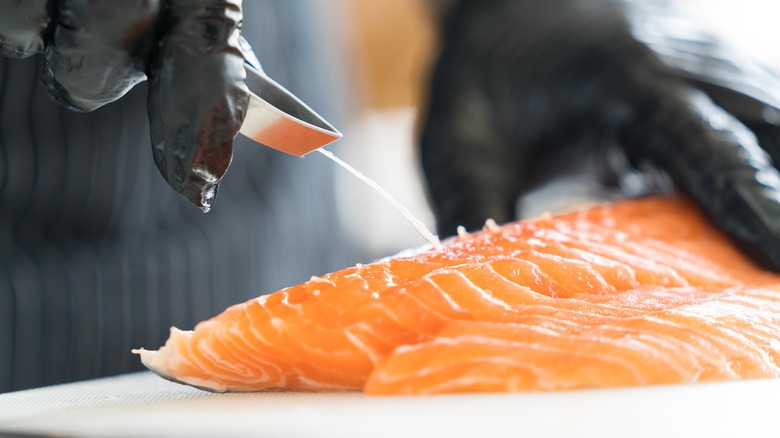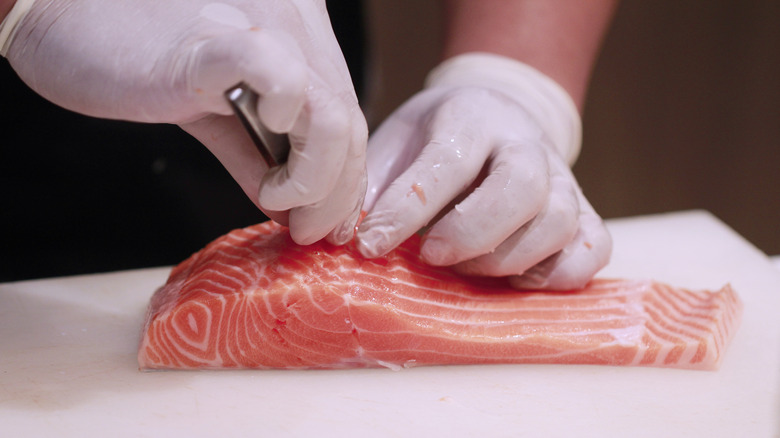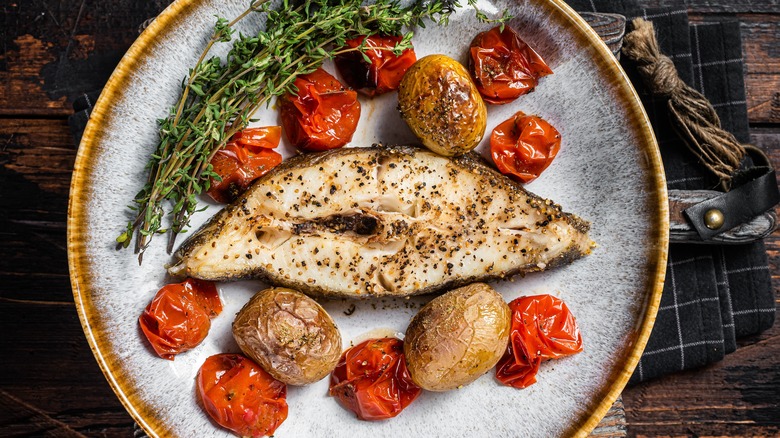How To Easily Remove Pin Bones From Fish Fillets
Imagine biting into a piece of homemade simple Dijon-crusted salmon and feeling a tiny sliver of something hard. Not only is this undesirable, but it can also be downright dangerous. Even the best fishmonger may miss a pin bone or two, making knowing how to remove them an important skill.
Pin bones lie at an angle in the flesh. To remove them without ripping out chunks and mangling the meat, it's critical to pull in the direction the pin bone is pointing. It's akin to cutting beef with the grain — you want to pull with the pin.
You can use tweezers or pliers designed for the task, or sanitize a pair found in your home. Run your hand along the flesh in the opposite direction of the bones to get a rough idea of how many you are working with, and to raise them slightly for a better grip — think of petting a cat's hair against the direction of its growth (thankfully, the fillet won't dislike this nearly as much as a cat would). Using your non-dominant hand, hold the flesh taut as you grab the bone at an angle. It takes a firm tug to release the bone from the flesh. Once the bone is out, set it to the side and get to work on the next one. The pin bones are a bit slippery, so placing a paper towel or dish towel next to you to wipe the tweezers on and release them can be helpful.
What are pin bones?
Pin bones are long, thin, needle-like bones found in fish that resemble, well, a pin. They are technically not actual bones, but calcified nerve endings that help the fish sense others nearby and keep the muscle attached to the fish. They are usually about one to two inches in length and evenly spaced out, much like a human's vertebrae. Pin bones are most often found in the thickest part of the fillet, growing in size and thickness from the tail to the head of the fish. The bones tend to stick out of the flesh of the fillet for a fraction of an inch — just enough of a tip to grab with tweezers or needle-nosed pliers.
Some types of fish have more pin bones than others, and some species have none at all. Salmon and trout tend to contain a healthy dose of pin bones. Flatfish, such as one you'd choose for an Italian pan-seared sole, do not contain any. Fish that have been cut into steaks, like tuna or halibut, are also less likely to contain them. You're also much less likely to find any pin bones in swordfish, grouper, mahi mahi, whitefish, or perch, so feel free to put down the pliers for those mahi mahi tacos.
What happens if you eat a pin bone?
If you're wondering if you can eat and digest pin bones, yes, you can. In fact, they are rich in calcium and iron. But whether you should opt to eat them — that is another question. While it may seem like a tedious task, removing the pin bones one by one is probably best for both your enjoyment of the fish and, more importantly, your safety.
Albeit small, not only are pin bones a choking hazard, but they can also get lodged in your throat and possibly require surgery to remove, as they can damage your esophagus. If you miss one during prep and your teeth don't catch it first, don't fret if you swallow it and feel a tickle in your throat — there are a few tricks to remove a stuck bone.
Think slippery: Swallowing a couple of tablespoons of olive oil can help push it down your throat or help you cough it up. On that note, simply coughing a few times can help dislodge it before you try other methods. A few bites of banana can also help you swallow it fully and move it through your digestive tract, as will a bit of bread soaked in water or with a smear of peanut butter. You can also just try giving it time to dislodge on its own, but when in doubt, seek a doctor.



